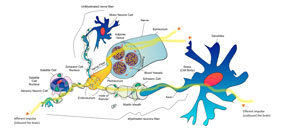Crossref Citations
This article has been cited by the following publications. This list is generated based on data provided by Crossref.
Accardo, Angelo
Shalabaeva, Victoria
and
LaRocca, Rosanna
2018.
Colon cancer cells adhesion on polymeric nanostructured surfaces.
MRS Communications,
Vol. 8,
Issue. 1,
p.
35.
Maiti, Binoy
and
Díaz Díaz, David
2018.
3D Printed Polymeric Hydrogels for Nerve Regeneration.
Polymers,
Vol. 10,
Issue. 9,
p.
1041.
Trejo, JosÉ L.
2018.
Advances in the Ongoing Battle against the Consequences of Peripheral Nerve Injuries.
The Anatomical Record,
Vol. 301,
Issue. 10,
p.
1606.
Tullii, Gabriele
Giona, Federica
Lodola, Francesco
Bonfadini, Silvio
Bossio, Caterina
Varo, Simone
Desii, Andrea
Criante, Luigino
Sala, Carlo
Pasini, Mariacecilia
Verpelli, Chiara
Galeotti, Francesco
and
Antognazza, Maria Rosa
2019.
High-Aspect-Ratio Semiconducting Polymer Pillars for 3D Cell Cultures.
ACS Applied Materials & Interfaces,
Vol. 11,
Issue. 31,
p.
28125.
Ghorbani, Farnaz
Ghalandari, Behafarid
Ghorbani, Farimah
and
Zamanian, Ali
2020.
Effects of lamellar microstructure of retinoic acid loaded-matrixes on physicochemical properties, migration, and neural differentiation of P19 embryonic carcinoma cells.
Journal of Polymer Engineering,
Vol. 40,
Issue. 8,
p.
647.
Thampi, Sudhin
Thekkuveettil, Anoopkumar
Muthuvijayan, Vignesh
and
Parameswaran, Ramesh
2020.
Accelerated Outgrowth of Neurites on Graphene Oxide-Based Hybrid Electrospun Fibro-Porous Polymeric Substrates.
ACS Applied Bio Materials,
Vol. 3,
Issue. 4,
p.
2160.
Maity, Santu
Chatterjee, Aroni
and
Ganguly, Jhuma
2020.
Green Approaches in Medicinal Chemistry for Sustainable Drug Design.
p.
617.
Jamalpour, Mohammad Reza
Vahdatinia, Farshid
Vargas, Jessica
and
Tayebi, Lobat
2020.
Applications of Biomedical Engineering in Dentistry.
p.
223.
Pinzon-Herrera, Luis
Mendez-Vega, Janet
Mulero-Russe, Adriana
Castilla-Casadiego, David A.
and
Almodovar, Jorge
2020.
Real-time monitoring of human Schwann cells on heparin-collagen coatings reveals enhanced adhesion and growth factor response.
Journal of Materials Chemistry B,
Vol. 8,
Issue. 38,
p.
8809.
Hassan, Najam ul
Chaudhery, Iqra
ur.Rehman, Asim.
and
Ahmed, Naveed
2021.
Advances in Polymeric Nanomaterials for Biomedical Applications.
p.
191.
Amini, Shahram
Salehi, Hossein
Setayeshmehr, Mohsen
and
Ghorbani, Masoud
2021.
Natural and synthetic polymeric scaffolds used in peripheral nerve tissue engineering: Advantages and disadvantages.
Polymers for Advanced Technologies,
Vol. 32,
Issue. 6,
p.
2267.
Yang, Chun-Yi
Huang, Wei-Yuan
Chen, Liang-Hsin
Liang, Nai-Wen
Wang, Huan-Chih
Lu, Jiaju
Wang, Xiumei
and
Wang, Tzu-Wei
2021.
Neural tissue engineering: the influence of scaffold surface topography and extracellular matrix microenvironment.
Journal of Materials Chemistry B,
Vol. 9,
Issue. 3,
p.
567.
Milos, Frano
Tullii, Gabriele
Gobbo, Federico
Lodola, Francesco
Galeotti, Francesco
Verpelli, Chiara
Mayer, Dirk
Maybeck, Vanessa
Offenhäusser, Andreas
and
Antognazza, Maria Rosa
2021.
High Aspect Ratio and Light-Sensitive Micropillars Based on a Semiconducting Polymer Optically Regulate Neuronal Growth.
ACS Applied Materials & Interfaces,
Vol. 13,
Issue. 20,
p.
23438.
Havins, Laurissa
Capel, Andrew
Christie, Steve
Lewis, Mark
and
Roach, P
2022.
Gradient biomimetic platforms for neurogenesis studies.
Journal of Neural Engineering,
Vol. 19,
Issue. 1,
p.
011001.
Buentello, David Choy
García-Corral, Mariana
Trujillo-de Santiago, Grissel
and
Alvarez, Mario Moisés
2024.
Neuron(s)-on-a-Chip: A Review of the Design and Use of Microfluidic Systems for Neural Tissue Culture.
IEEE Reviews in Biomedical Engineering,
Vol. 17,
Issue. ,
p.
243.
Čiužas, Darius
Krugly, Edvinas
and
Petrikaitė, Vilma
2024.
The fabrication method impacts biological properties of microfibrous three-dimensional in vitro cell culture scaffolds and their applications in drug screening.
Materials Today Communications,
Vol. 39,
Issue. ,
p.
108707.
Ghaiedi, Homa
Pinzon Herrera, Luis Carlos
Alshafeay, Saja
Harris, Leonard
Almodovar, Jorge
and
Nayani, Karthik
2024.
Liquid crystalline collagen assemblies as substrates for directed alignment of human Schwann cells.
Soft Matter,
Vol. 20,
Issue. 45,
p.
8997.
Mittal, Pooja
Chopra, Hitesh
Kapoor, Ramit
and
Mishra, Brahmeshwar
2024.
Polysaccharides-Based Hydrogels.
p.
429.
Papadimitriou, Lina
Karagiannaki, Anna
Stratakis, Emmanuel
and
Ranella, Anthi
2024.
Substrate topography affects PC12 cell differentiation through mechanotransduction mechanisms.
Mechanobiology in Medicine ,
Vol. 2,
Issue. 1,
p.
100039.
Pinzon‐Herrera, Luis
Magness, John
Apodaca‐Reyes, Hector
Sanchez, Jesus
and
Almodovar, Jorge
2024.
Surface Modification of Nerve Guide Conduits with ECM Coatings and Investigating Their Impact on Schwann Cell Response.
Advanced Healthcare Materials,
Vol. 13,
Issue. 14,


